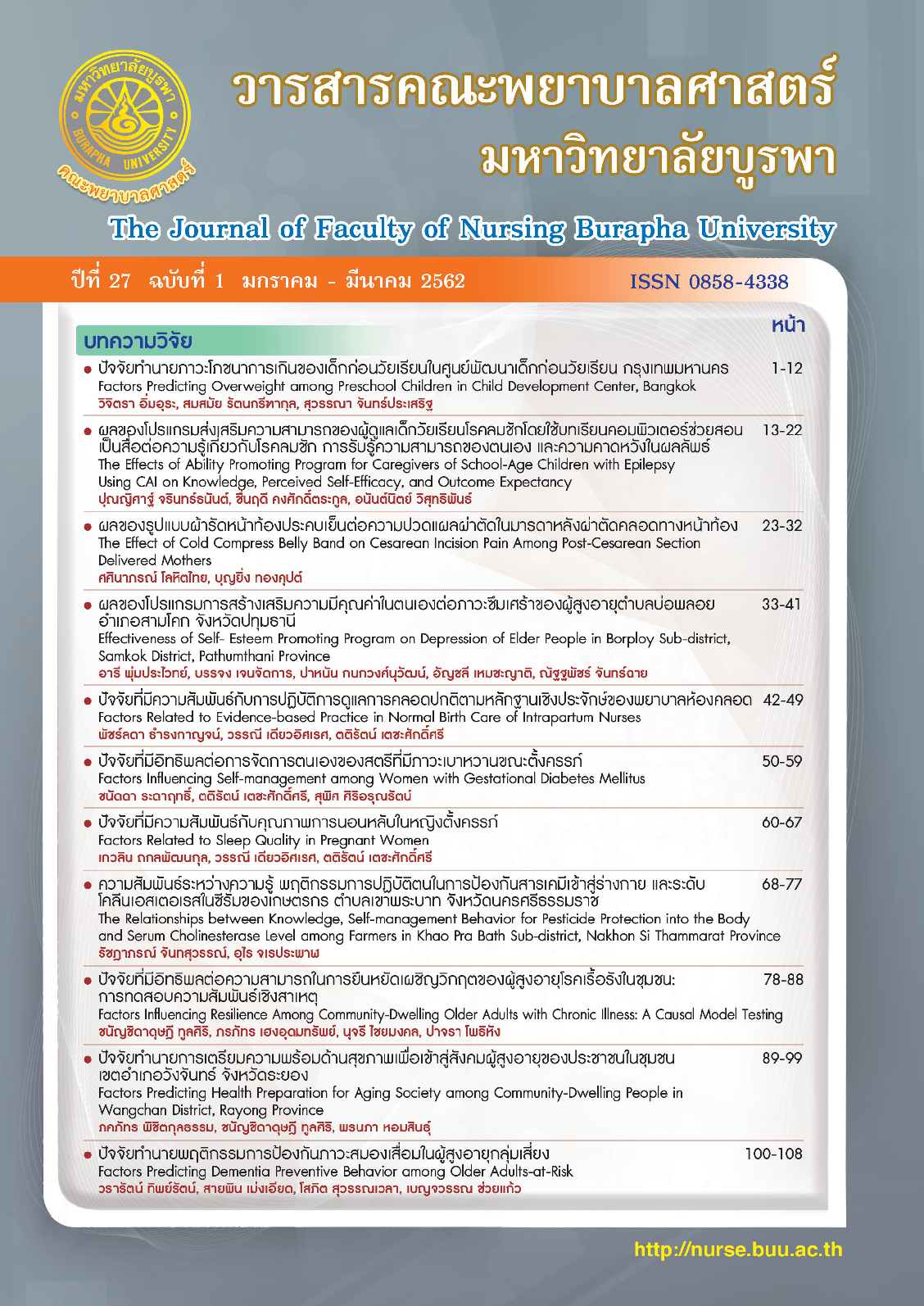ความสัมพันธ์ระหว่างความรู้ พฤติกรรมการปฏิบัติตนในการป้องกันสารเคมีเข้าสู่ร่างกาย และระดับโคลีนเอสเตอเรสในซีรั่มของเกษตรกร ตำบลเขาพระบาท จังหวัดนครศรีธรรมราช
คำสำคัญ:
ความรู้, พฤติกรรมการปฏิบัติตน, การป้องกันสารเคมีเข้าสู่ร่างกาย, ระดับโคลีนเอสเตอเรสในซีรั่ม, เกษตรกรบทคัดย่อ
บทคัดย่อ
การศึกษาแบบภาคตัดขวางเชิงวิเคราะห์นี้ มีวัตถุประสงค์เพื่อศึกษาความสัมพันธ์ระหว่างความรู้ พฤติกรรมการปฏิบัติตนในการป้องกันสารเคมีเข้าสู่ร่างกาย และระดับเอนไซม์โคลีนเอสเตอเรสในซีรั่มของเกษตรกรในตำบลเขาพระบาท อำเภอเชียรใหญ่ จังหวัดนครศรีธรรมราช กลุ่มตัวอย่างคัดเลือกแบบบังเอิญ จาก 9 หมู่บ้าน ในปีพ.ศ. 2560 จำนวน 411 คน เครื่องมือวิจัยได้แก่ แบบสอบถามข้อมูลทั่วไป แบบทดสอบความรู้เกี่ยวกับการใช้สารเคมีกำจัดศัตรูพืช และแบบสอบถามพฤติกรรมการปฏิบัติตนในการป้องกันสารเคมีเข้าสู่ร่างกาย มีค่าความเชื่อมั่นเท่ากับ .98 และ .72 ตามลำดับ วิเคราะห์ข้อมูลโดยใช้ร้อยละ ค่าเฉลี่ย ส่วนเบี่ยงเบนมาตรฐาน และการทดสอบไคสแควร์
ผลการวิจัยพบว่ากลุ่มตัวอย่างมีความรู้เกี่ยวกับการใช้สารเคมีอยู่ในระดับปานกลางและมาก ร้อยละ 55.00 และ 42.80 ตามลำดับ ความรู้ไม่มีความสัมพันธ์กับระดับเอนไซม์โคลีนเอสเตอเรสในซีรั่ม (p>.05) พฤติกรรมป้องกันความเสี่ยงจากสารเคมีกำจัดศัตรูพืชอยู่ในระดับมากและปานกลาง ร้อยละ 89.80 และ 10.2 ตามลำดับ กลุ่มที่มีพฤติกรรมการป้องกันอยู่ในระดับมาก มีระดับโคลีนเอสเตอเรสในซีรั่มอยู่ในระดับปกติ/ปลอดภัยมากกว่ากลุ่มที่อยู่ในระดับเสี่ยง/ไม่ปลอดภัย และพฤติกรรมการป้องกันมีความสัมพันธ์กับระดับโคลีนเอสเตอเรสในซีรั่มอย่างมีนัยสำคัญทางสถิติ (c2= 3.88, p<.05) ผลการวิจัยนี้ให้ข้อเสนอแนะว่าพยาบาลวิชาชีพที่ปฏิบัติงานในชุมชน ควรส่งเสริมให้เกษตรกรมีพฤติกรรมที่เหมาะสมเพื่อป้องกันสารเคมีกำจัดศัตรูพืชเข้าสู่ร่างกายได้อย่างมีประสิทธิภาพ
เอกสารอ้างอิง
Angsungnern, S. (2015). Environmental impact from pesticide utilization. EAU Heritage Journal: Science and Technology, 9(1), 50-63. [In Thai]
Bureau of Occupational and Environmental Diseases. (2017). Health effects of pesticides. Retrieved from http://envocc.ddc.moph.go.th/contents/view/106 [In Thai]
Duangchinda, A., Anurugsa, B., & Hungspreug, N. (2014). The use of organophosphate and carbamate pesticide on paddy fields and cholinesterase level of farmers in Sam Chuk district, Suphan Buri province. Thammasat International Journal of Science and Technology, 19(1), 39-51. [In Thai]
Environmental Research and Training Center, Department of Environmental Quality Promotion, Ministry of Natural Resources and Environment. (2014). A study on the development of methods for reducing chemical use in agriculture using participatory research : A case study in Mae Taeng district, Chiangmai province. Pathum Thani: Environmental Research and Training Center. [In Thai]
Kachaiyaphum, P., Howteerakul, N., Sujirarat, D., Siri, S., & Suwannapong, N. (2010). Serum cholinesterase levels of Thai Chilli-Farm workers Exposed to chemical pesticides: prevalence estimate and associated factors. Journal of Occupational Health, 52, 89-98. [In Thai]
Khao Pra Bath Sub-district Health Promoting Hospital. (2017). Report on chemical residues in fruits and vegetables, Khao Pra Bath Sub-district Health Promoting Hospital. Nakhon Si Thammarat province: Khao Pra Bath Sub-district Health Promoting Hospital. [In Thai]
Kobjai, W., Damrongsat, A., & Panta, P. (2010). Behavior of using pesticide and cholinesterase blood level of riverhead agriculture group: A case study of Mong Hilltribe, Phayao province. Journal of Health Science Research, 4(2), 36-46. [In Thai]
National Statistical Office, Ministry of Digital Economy. (2017). Survey results of working population (February, 2560). Retrieved from http://service.nso.go.th/nso/nsopublish/ themes/files/lfs60/reportFeb.pdf [In Thai]
Office of Agricultural Economics. (2018). Import volume and value of agricultural hazardous substances 2011 – 2016. Retrieved from http://oldweb.oae.go.th/economicdata/ pesticides.html [In Thai]
Piromchit, P., & Paileeklee, S. (2014). Knowledge and behavior regarding pesticide use among agriculturists in Ban Na Lao, Na Wang district, Nong Bua Lam Phu province. Community Health Development Quarterly Khon Kaen University, 2(3), 299-309. [In Thai]
Pluemchan, N., & Khansakorn, N. (2015). Factors associated with blood cholinesterase enzyme level of agricultural workers in Ko-Chan sub-district, Ko-Chan district, Chon Buri province. Thai Journal Toxicology, 30(2), 128-141. [In Thai]
Pretty, J., & Bharucha, Z. P. (2015). Integrated pest management for sustainable intensification of agriculture in Asia and Africa. Insect, 6(1), 152-182. doi:10.3390/insects6010152
Sirirat, J., Srimanee, J., Phuyorit, S., Punechouy, P., Chaladleard, P., Chuchert, T., & et al. (2016). Descriptive analysis of pesticide toxic effect surveillance data system in 5 dimensions of operation. In Hinjoy, S., Tiprat, K., Taechakamonsuk, P., Editors, Conclusions of the surveillance system analysis approach 5 groups of diseases in 5 dimensions (p. 138-147). Nonthaburi: Bureau of Epidemiology, Department of Disease Control, Ministry of Public Health. [In Thai]
Thailand Pesticide Alert Network. (2016). Surveillance of pesticide residues in fruits and vegetables for the year 2016. Retrieved from: http://www.thaipan.org/sites/default/ files/file/pesticide_doc24_press_4_5_2559.pdf [In Thai]
Yamane, T. (1967). Statistics: An introductory analysis. 2nd. New York: Harper & Row.
Warwick, D. (1983). The KAP survey: Dictates of mission versus demands of science. London: Harvard Institute for International Development.
Wongsakoonkan, W., Mangkornthong, S., & Tiangthae, P. (2018). Pesticide usage behavior and cholinesterase blood level of farmers: Case study of Latlumkaeo district, Pathumthani province. Ratchaphruek Journal, 16(1), 55-64. [In Thai]





